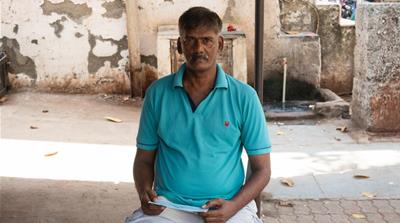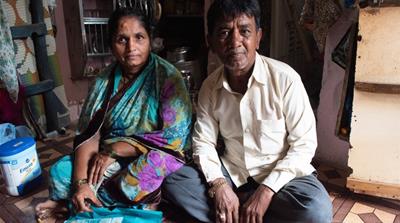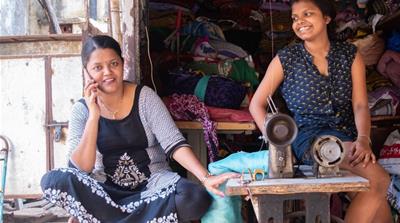Banking in India: Why many people still don’t use their accounts
Despite a big government push to sign up bank-account holders, many hurdles prevent people from using them.

Mumbai, India: About three years ago, Gautam More received a no-frills bank account under an Indian government scheme to bring low-income households like his into the formal financial system. Until then, the carpenter from central Mumbai, like hundreds of millions of other Indians, had always relied on cash.
After joining the ranks of what policymakers call the “newly banked”, More, 52, assumed it would be easier to borrow money and protect his family against financial emergencies. But he soon learned the shortcomings of his new account.
Keep reading
list of 4 items‘We share with rats’: Neglect, empty promises for S African hostel-dwellers
Thirty years waiting for a house: South Africa’s ‘backyard’ dwellers
Photos: Malnutrition threatens future Afghan generations
“I still can’t get a loan for my daughter’s wedding since I still have no savings,” he told Al Jazeera. “What was the point of it all?”
The scheme has been enormously successful in equipping people with bank accounts for the first time, and a growing amount of government subsidies are being paid into these, meaning that more of these accounts are operative. But the numbers of people able to access credit, plan for their financial future and be independent have barely grown, meaning few lives are being changed, analysts say. And women remain particularly disadvantaged.
The World Bank’s 2017 Global Findex Database shows that nearly 80 percent of Indian people had a bank account at the time of the survey, up from 53 percent in 2014. This rapid growth has been driven by Prime Minister Narendra Modi‘s flagship Jan Dhan – or “people’s wealth” – programme, which opened more than 355 million accounts in India’s state and private sector banks in five years.
Together with the roll-out of the world’s largest national biometric identity programme, Aadhaar, and high mobile phone penetration rates, the government claims to have revolutionised financial inclusion through what it calls the JAM (Jan Dhan-Aadhaar-Mobile) trinity.
The confluence of these three factors has helped authorities make social security payments directly into people’s accounts, reducing fraud and corruption and improving efficiency in India’s welfare system. Jan Dhan accounts also feature in-built insurance and pension products, which should provide easier access to credit, for example, through an overdraft facility that was recently doubled to 10,000 Indian rupees ($144).
Yet despite the rapid provision of bank accounts to almost every household in the country, World Bank data also shows that half of India’s bank accounts are inactive. That is double the average rate found in developing economies, suggesting Modi’s high-profile campaign still has a long way to go.
Government figures show that 83 percent of accounts opened under its people’s wealth scheme have seen at least one transaction in the past year, technically making them “active”. But analysts say the activity reflects social benefits being paid in by the government, and that account holders are not necessarily using them to deposit their savings or carry out other transactions.

Rajat Kathuria, director of the Indian Council for Research on International Economic Relations (ICRIER), is not surprised that bank account usage in India remains low. Accounts are opened by “people with nothing to put in them”, which means banks don’t find it profitable to service these customers and focus on making them operational, he says.
“The creation of a formal banking system is really a spillover effect that was not policymakers’ main objective,” he told Al Jazeera. “One thought was to get the plumbing out of the way, then figure out how to make the accounts operational later.”
Poor understanding means low usage
In an economy where 90 percent of transactions are still made using cash, visiting a bank can seem like a chore.
“When household work piles up, it’s not convenient to keep depositing cash only to withdraw it again the next day,” Vandana Meghal, a tailor in central Mumbai, told Al Jazeera. She explained that while many women in her neighbourhood now have bank accounts, accessing them can mean losing time and the opportunity to do other important work.
Low financial literacy levels – India ranked near the bottom among Asia-Pacific countries in a 2015 report by credit card company Mastercard – mean that many people remain unaware of the potential benefits they could reap from their new Jan Dhan accounts.
“[The government has] incentivised people to open these accounts, but has done less to increase usage or provide them with enough information,” Rohini Pande, an economics professor at Harvard University’s John F Kennedy School of Government, told Al Jazeera. Pande said poor training programmes and an initial focus on hitting account-opening targets meant that bank staff often fail to communicate all the benefits.
Mohammed and Mehrulnissa Sheikh, a sexagenarian couple living off 200 Indian rupees ($2.80) a day, had never heard of the overdraft or life insurance facilities attached to their Jan Dhan accounts.
“Whatever 10 or 20 rupees we have spare, we put that aside for our granddaughter,” Mohammed Sheikh told Al Jazeera. “With nothing left after buying food, we don’t see the point in using these accounts.”

Many people in the area still turn to informal moneylenders who charge high interest rates and “take your housing ownership papers as security”, he said. “They really harass you”.
The World Bank says only seven percent of people in India borrowed from an established, licensed financial institution in 2017, a rate that has changed little in five years despite the explosion of formally “banked” individuals.
“There are still very few places you can get a credit line if you’re poor,” said Harvard’s Pande.
“[Banks] will also screen you by lending only small amounts at first and changing the loan size over time, rather than taking a chance on a low-income borrower,” she added. This is one reason why many may not bother with formal banking options.
So it is little surprise that informal savings groups remain popular, especially among women.
Meghal, the central Mumbai tailor, runs such a community savings group, or “kitty”, for a dozen local women who each deposit 1,000 Indian rupees ($14) a month and take it in turns to safeguard the cash.
If someone has an urgent need to pay school fees or medical bills, the group allocates the funds to them, since “the bank can take a month to process a loan application”, she said.
“This way is better, you get hold of money quickly and without accruing interest.”
Is technology a solution?
But a more sustainable solution may involve mobile phone technology.
Although 88 percent of Indian households own a mobile phone, according to People Research on India’s Consumer Economy, a non-profit group, India lags behind countries like Kenya, where 73 percent of the population use mobile payment services, compared with just two percent in India.
Mobile money services can increase per capita consumption, stimulate entrepreneurship and reduce poverty, found a study by the Massachusetts Institute of Technology.
India now has some of the cheapest data plans globally, creating a potential for digital financial services to expand, especially to rural areas that are poorly served by bricks-and-mortar bank branches.
A “conservative regulatory body that has not provided regulatory room for innovation” is one reason why digital banking has not developed as fast, according to Pande, noting that the recent interest by authorities in creating so-called regulatory sandboxes – an environment for live-testing new products or services – is a promising step.
ICRIER’s Kathuria agrees, but also attributes Africa’s mobile banking success to its more “dysfunctional banking system” compared with that of India.
Consumers there had greater “initial need” and saw “higher incremental value” in external providers, he said. In Africa, “the likes of mPesa have essentially become the banking system themselves”.
Behaviour is also a factor. For example, digital payments rose by 43 percent the month after demonetisation in November 2016, when the Reserve Bank of India, the country’s central bank, removed 86 percent of the country’s currency notes overnight as part of an anti-corruption drive. However, the volume of cash circulating in the economy eventually returned to normal.
“People are still so comfortable with the touch and feel of cash that a major shift will take time to happen,” says Kathuria. He is optimistic, though, that mobile banking and financial literacy will grow as the “fear of technology” disappears and younger generations mature.
Another problem that needs fixing is India’s wide and persistent gender gap in many areas, including financial services. While mobile technology can bring more people into the formal banking system, India will need to tackle an imbalance that results in some women being left unable to make full use of, or even have access to, phones, according to Harvard University’s research.

“When these platforms get rolled out, at best they have quotas built in to target female users,” Pande said, adding that they rarely tackle the underlying factors keeping women away.
“We need to create products with an eye on these challenges,” she added.
Sociocultural norms frequently result in many women, especially in rural India, having reduced mobility outside their villages. They are deterred from approaching ATMs and payment points such as shops and post offices if they are in areas dominated by men, and few know how to use their phones for more than to receive calls, Harvard’s Pande explained.
“Banks should look at increasing the density of payment points, hiring more female staff and running effective training programmes” as a way to be more inclusive, Pande advised, though acknowledging that this may not be a priority for private lenders.
Google’s Internet Saathi (Internet Partner) programme is one example of an “innovative strategy” aiming to bridge the online gender divide, says Vidisha Mishra, a senior research associate at the Observer Research Foundation, a think-tank.
She praises initiatives that place female trainers alongside women who need help with financial literacy. Such programmes educate women about smartphone features and open up the possibility for them to use mobile banking, Mishra told Al Jazeera.
“Purely tech solutions don’t focus enough on the norms that hold women back,” Mishra said, adding that this programme properly shows women how these services can make their everyday life better. “It has to be pitched like that to see results,” she added.
Sitting behind her sewing machine, humming to vintage Hindi songs on a nearby radio, Meghal, a self-taught and financially savvy entrepreneur, is proud to play a similar role.
A year ago, she took out a car loan and began driving for several ride-hailing apps, like Uber. She eventually failed to keep up with the monthly payments and had to surrender the car. But her experience has made her an inspiration and reliable source of information for the women in her neighbourhood.
“If someone’s husband has just got laid off and the wife wants to start a small business to help out, they will come to ask me for help for first,” she says. “I don’t mind. I have a lot of time to listen.”